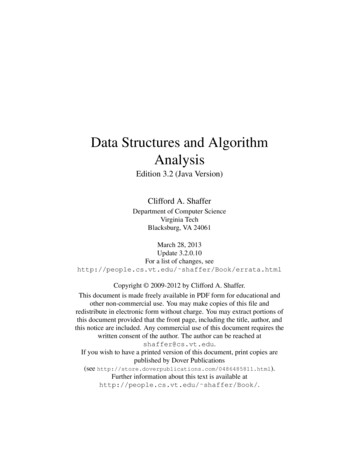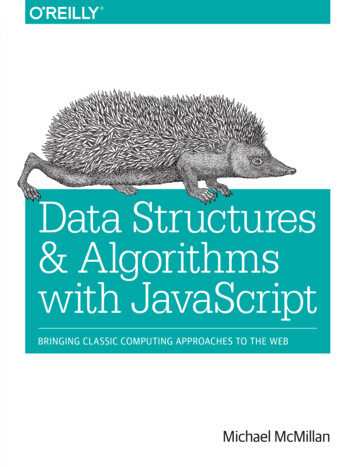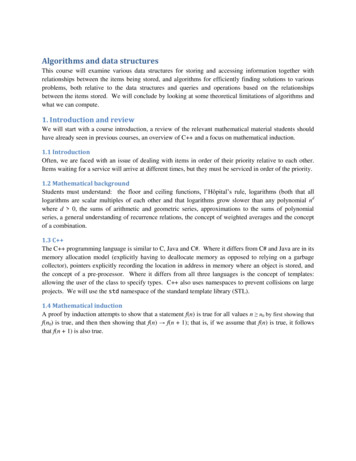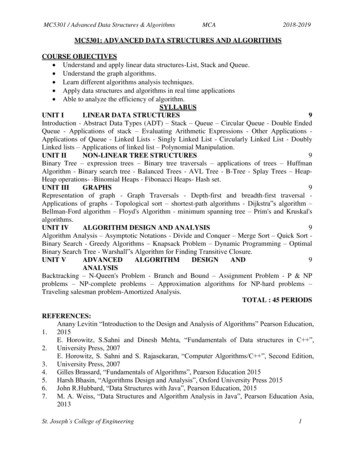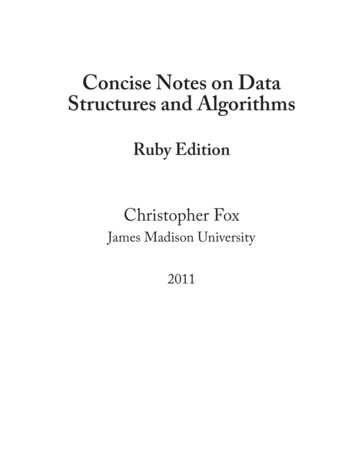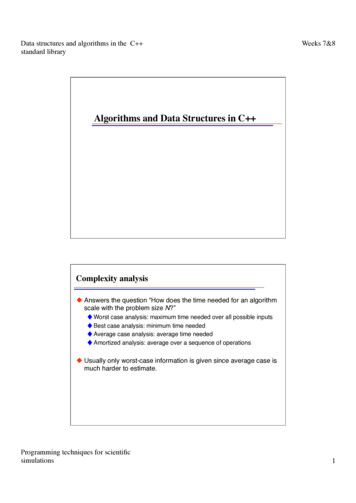
Transcription
Data structures and algorithms in the C standard libraryWeeks 7&8Algorithms and Data Structures in C Complexity analysis Answers the question “How does the time needed for an algorithmscale with the problem size N?”" Worst case analysis: maximum time needed over all possible inputs" Best case analysis: minimum time needed" Average case analysis: average time needed" Amortized analysis: average over a sequence of operations" Usually only worst-case information is given since average case ismuch harder to estimate."Programming techniques for scientificsimulations1
Data structures and algorithms in the C standard libraryWeeks 7&8The O notation Is used for worst case analysis:An algorithm is O(f (N)) if there are constants c and N0, such that forN N0 the time to perform the algorithm for an input size N isbounded by t(N) c f(N) Consequences " O(f(N)) is identically the same as O(a f(N)) O(a Nx b Ny) is identically the same as O(Nmax(x,y))" O(Nx) implies O(Ny) for all y xThe Ω and Θ notations Ω is used for best case analysis:An algorithm is Ω(f (N)) if there are constants c and N0, such that forN N0 the time to perform the algorithm for an input size N isbounded by t(N) c f(N) Θ is used if worst and best case scale the sameData structures and algorithms in the C standardlibrary An algorithm is Θ(f (N)) if it is Ω(f (N)) and O(f (N)) "Programming techniques for scientificsimulations2
Data structures and algorithms in the C standard libraryWeeks 7&8Time assuming 1 billion operations per secondComplexity"N 10"102"103"104"105"106"1"1 ns"1 ns"1 ns"1 ns"1 ns"1ns"ln N"3 ns"7 ns"10 ns"13 ns"17 ns"20 ns"N"10 ns"100 ns"1 µs"10 µs"100 µs"1 ms"N log N"33 ns"664 ns"10 µs"133 µs"1.7 ms"20 ms"N2"100 ns"10 µs"1 ms"100 ms"10 s"17 min"N3"1 µs"1 ms"1 s"17 min"11.5 d"31 a"2N"1 µs"1014 a"10285 a"102996 a"1030086 a" 10301013 a"Which algorithm do you prefer? When do you pick algorithm A, when algorithm B? The complexities arelisted below "Algorithm A"Algorithm B"O(ln N)O(N)O(ln N)NO(ln N)1000 Nln NO(N)1000 ln NO(N)ln NNln N1000 N1000 ln NNProgramming techniques for scientificsimulationsWhich do you pick?"3
Data structures and algorithms in the C standard libraryWeeks 7&8Complexity: example 1 What is the O, Ω and Θ complexity of the following code?double x;std::cin x;std::cout std::sqrt(x);"Complexity: example 2 What is the O, Ω and Θ complexity of the following code?unsigned int n;std::cin n;for (int i 0; i n; i)std::cout i*i “\n”;"Programming techniques for scientificsimulations4
Data structures and algorithms in the C standard libraryWeeks 7&8Complexity: example 3 What is the O, Ω and Θ complexity of the following code?unsigned int n;std::cin n;for (int i 0; i n; i) {unsigned int sum 0;for (int j 0; j i; j)sum j;std::cout sum “\n”;}"Complexity: example 4 What is the O, Ω and Θ complexity of the following two segments?" Part 1:unsigned int n;std::cin n;double* x new double[n]; // allocate array of n numbersfor (int i 0; i n; i)std::cin x[i]; Part 2:double y;std::cin y;for (int i 0; i n; i)if (x[i] y) {std::cout i “\n”;break;}Programming techniques for scientificsimulations5
Data structures and algorithms in the C standard libraryWeeks 7&8Complexity: adding to an array (simple way) What is the complexity of adding an element to the end of anarray?" allocate a new array with N 1 entries" copy N old entries" delete old arrray" write (N 1)-st element" The complexity is O(N)"Complexity: adding to an array (clever way) What is the complexity of adding an element to the end of anarray?" allocate a new array with 2N entries, but mark only N 1 as used" copy N old entries" delete old arrray" write (N 1)-st element" The complexity is O(N), but letʼs look at the next elements added:" mark one more element as used" write additional element" The complexity here is O(1)" The amortized (averaged) complexity for N elements added is"1(O(N) (N 1)O(1)) O(1)NProgramming techniques for scientificsimulations6
Data structures and algorithms in the C standard libraryWeeks 7&8STL: Standard Template Library Most notable example of generic programming" Widely used in practice" Theory: Stepanov, Musser; Implementation: Stepanov, Lee" Standard Template Library" Proposed to the ANSI/ISO C Standards Committee in 1994." After small revisions, part of the official C standard in 1997."The standard C libraryallocatorsallocatoryour allocatorcontainersfunction objectsnegate, plus, multiplies, your functionpredicatesless, greater, equal to, your predicatedata sequencessequence algorithmsaccumulate, inner product,find, reverse, sort, merge, your algorithmlist, vector, dequemap, set, your containerbuiltin arrays,iostreams,your data structurecontainer adaptersstack, queue, priority queueProgramming techniques for scientificsimulations7
Data structures and algorithms in the C standard libraryWeeks 7&8The string and wstring classes are very useful class to manipulate strings" string for standard ASCII strings (e.g. “English”)" wstring for wide character strings (e.g. “日本語”)" Contains many useful functions for string manipulation" Adding strings" Counting and searching of characters" Finding substrings" Erasing substrings" " Since this is not very important for numerical simulations I will notgo into details. Please read your C book"The pair template template class T1, class T2 class pair {public:T1 first;T2 second;pair(const T1& f, const T2& s): first(f), second(s){}}; will be useful in a number of places"Programming techniques for scientificsimulations8
Data structures and algorithms in the C standard libraryWeeks 7&8Data structures in C We will discuss a number of data structures and their implementationin C :" Arrays: " C array" vector" valarray" deque" Linked lists: " list" Trees" map" set" multimap" multiset" Queues and stacks" queue" priority queue" stack"The array or vector data structure An array/vector is a consecutive range in memory" Advantages" Fast O(1) access to arbitrary elements: a[i] is *(a i)" Profits from cache effects" Insertion or removal at the end is O(1)" Searching in a sorted array is O(ln N)" Disadvantage" Insertion and removal at arbitrary positions is O(N)"Programming techniques for scientificsimulations9
Data structures and algorithms in the C standard libraryWeeks 7&8Slow O(N) insertion and removal in an array Inserting an element" Need to copy O(N) elements"abcdefghabcdxefgh Removing an element" Also need to copy O(N) elements"abcdabcefghefghFast O(1) removal and insertion at the end of an array Removing the last element" Just change the size" Capacity 8, size 6:"abcdef Capacity 8, size 5:"abcdespareelements Inserting elements at the end" Is amortized O(1)" first double the size and copy in O(N):"abcdabcdeabcdefabcdefg then just change the size:"Programming techniques for scientificsimulations10
Data structures and algorithms in the C standard libraryWeeks 7&8The deque data structure (double ended queue) Is a variant of an array, more complicated to implement" See a data structures book for details" In addition to the array operations also the insertion and removal atbeginning is O(1) Is needed to implement queues"The stack data structure Is like a pile of books" LIFO (last in first out): the last one in is the first one out" Allows in O(1)" Pushing an element to the top of the stack" Accessing the top-most element" Removing the top-most element"Programming techniques for scientificsimulationsinout11
Data structures and algorithms in the C standard libraryWeeks 7&8The queue data structure Is like a queue in the Mensa" FIFO (first in first out): the first one in is the first one out" Allows in O(1)" Pushing an element to the end of the queue" Accessing the first and last element"in Removing the first element"outThe priority queue data structure Is like a queue in the Mensa, but professors are allowed to go tothe head of the queue (not passing other professors though)" The element with highest priority (as given by the relation) is the firstone out" If there are elements with equal priority, the first one in the queue isthe first one out" There are a number of possible implementations, look at a datastructure book for details"Programming techniques for scientificsimulations12
Data structures and algorithms in the C standard libraryWeeks 7&8The linked list data structure An linked list is a collection of objects linked by pointers into a onedimensional sequence"headtail Advantages" Fast O(1) insertion and removal anywhere" Just reconnect the pointers" Disadvantage" Does not profit from cache effects" Access to an arbitrary element is O(N)" Searching in a list is O(N)"The tree data structures An array needs" O(N) operations for arbitrary insertions and removals" O(1) operations for random access" O(N) operations for searches" O(ln N) operations for searches in a sorted array" A list needs" O(1) operations for arbitrary insertions and removals" O(N) operations for random access and searches" What if both need to be fast? Use a tree data structure:" O(ln N) operations for arbitrary insertions and removals" O(ln N) operations for random access and searches"Programming techniques for scientificsimulations13
Data structures and algorithms in the C standard libraryWeeks 7&8A node in a binary tree Each node is always linked to two child nodes" The left child is always smaller" The right child node is always larger"msdA binary tree Can store N 2n-1 nodes in a tree of height n! Any access needs at most n O(ln N) steps! Example: a tree of height 5 with 12 nodes"rootmbranchsdbagxniwyzleafProgramming techniques for scientificsimulations14
Data structures and algorithms in the C standard libraryWeeks 7&8Unbalanced trees Trees can become unbalanced" Height is no longer O(ln N) but O(N)" All operations become O(N)" Solutions"abc Rebalance the tree" Use self-balancing trees"de Look into a data structures book to learn more"fghTree data structures in the C standard Fortunately the C standard contains a number of self-balancingtree data structures suitable for most purposes:" set" multiset" map" multimap" But be aware that computer scientists know a large number ofother types of trees and data structures" Read the books" Ask the experts"Programming techniques for scientificsimulations15
Data structures and algorithms in the C standard libraryWeeks 7&8The container concept in the C standard Containers are sequences of data, in any of the data structures" vector T is an array of elements of type T" list T is a doubly linked list of elements of type T" set T is a tree of elements of type T " The standard assumes the following requirements for the elementT of a container:" default constructor T()" assignment T& operator (const T&)" copy constructor T(const T&)" Note once again that assignment and copy have to produce identicalcopy: in the Penna model the copy constructor should not mutate!"Connecting Algorithms to Sequencesfind( s, x ) : "! pos start of s"" while pos not at end of s"" "if element at pos in s x!" ""return pos!! !pos next position!" return pos"int find( char const(&s)[4], char x )"{"int pos 0;"while (pos ! sizeof(s))"{"if ( s[pos] x )"return pos;" pos;"}"return pos;"}"Programming techniques for scientificsimulationsstruct node"{"" char value;"" node* next;"};"node* find( node* const s, char x )"{"" node* pos s;"" while (pos ! 0)"" {"" "if ( pos- value x )"" ""return pos;!! !pos pos- next;!" }"" return pos;"}"16
Data structures and algorithms in the C standard libraryWeeks 7&8Connecting Algorithms to Sequencesfind( s, x ) : "! pos start of s"" while pos not at end of s"" "if element at pos in s x!" ""return pos!! !pos next position!" return pos"char* find(char const(&s)[4], char x)"{"" char* pos s;"" while (pos ! s sizeof(s))"" {"" " if ( *pos x )"" " " return pos;"" " pos;"" }"" return pos;"}"struct node"{"" char value;"" node* next;"};"node* find( node* const s, char x )"{"" node* pos s;"" while (pos ! 0)"" {"" "if ( pos- value x )"" ""return pos;!! !pos pos- next;!" }"" return pos;"}"Connecting Algorithms to Sequencesfind( s, x ) : "! pos start of s"" while pos not at end of s"" "if element at pos in s x!" ""return pos!! !pos next position!" return pos"char* find(char const(&s)[4], char x)"{"" char* pos s;"" while (pos ! s sizeof(s))"" {"" " if ( *pos x )"" " " return pos;"" " pos;"" }"" return pos;"}"Programming techniques for scientificsimulationsstruct node"{"" char value;"" node* next;"};"node* find( node* const s, char x )"{"" node* pos s;"" while (pos ! 0)"" {"" "if ( pos- value x )"" ""return pos;!! !pos pos- next;!" }"" return pos;"}"17
Data structures and algorithms in the C standard libraryWeeks 7&8NxM Algorithm """"" """"."."."N." har[5]""" "" ."" " ."."M." foobar"F. T. S. E.Fundamental Theorem of Software Engineering"!!!" "We can solve any problem by introducing an extralevel of indirection"!!! !--Butler Lampson!"Andrew KoenigProgramming techniques for scientificsimulations18
Data structures and algorithms in the C standard libraryWeeks 7&8Iterators to the Rescue Define a common interface for" traversal" access" positional comparison" Containers provide iterators" Algorithms operate on pairs of iterators"template class Iter, class T Iter find( Iter start, Iter finish, T x ){Iter pos start;for (; pos ! end; pos){if ( *pos x )return pos;}return pos;}struct node iterator{// .char& operator*() const{ return n- value; }node iterator& operator (){ n n- next; return *this; }private:node* n;};Describe Concepts for std::findtemplate class Iter, class T "Iter find(Iter start, Iter finish, T x)"{"" Iter pos start;"" for (; pos ! finish; pos)"" {"" "if ( *pos x )"" ""return pos;!" }"" return pos;"}"Programming techniques for scientificsimulations Concept Name?"Valid expressions? "Preconditions?"Postconditions? "Complexity guarantees? "Associated types?"19
Data structures and algorithms in the C standard libraryWeeks 7&8Traversing an array and a linked list Two ways for traversing an array Traversing a linked list" Using an index:"T* a new T[size];"for (int n 0;n size; n)"cout a[n]; Using pointers:"for (T* p a;"p ! a size; p)cout *p;"template class T struct node"{T value; // the elementnode T * next; // the next Node"};"template class T struct list"{node T * first;"};"list T l;" "for (mode T * p l.first;p! 0;p p- next)cout p- value;Generic traversal Can we traverse a vector and alist in the same way?" Instead of"for (T* p a;"p ! a size; p)cout *p;" We want to write"for (iterator p a.begin();"p ! a.end(); p)cout *p;"Programming techniques for scientificsimulations Instead of"" for (node T * p l.first;p! 0;p p- next)cout p- value;" We want to write"for (iterator p l.begin();"p ! l.end(); p)cout *p;"20
Data structures and algorithms in the C standard libraryWeeks 7&8Implementing iterators for the arraytemplate class T Now allows the desired syntax:"class Array {public:for (Array T ::iterator p typedef T* iterator;a.begin();"typedef unsigned size type;p ! a.end();Array(); p)Array(size type);cout *p;"iterator{ returniterator{ returnbegin()p ;}end()p sz ;} Instead offor (T* p a.p ;"p ! a.p a.sz ; p)cout *p;"private:T* p ;size type sz ;};"Implementing iterators for the linked listtemplate class T struct node iterator {Node T * p;node iterator(Node T * q) ": p(q) {}template class T class list {Node T * first;public:typedef node iterator T iterator;node iterator T & operator (){ p p- next;}iterator begin(){ return iterator(first);}T* operator - (){ return &(p- value);}iterator end(){ return iterator(0);}T& operator*(){ return p- value;}bool operator! (constnode iterator T & x){ return p! x.p;}// more operators missing };"Programming techniques for scientificsimulations};" Now also allows the desired syntax:"for (List T ::iterator p l.begin();"p ! l.end(); p)cout *p;"21
Data structures and algorithms in the C standard libraryWeeks 7&8Iterators have the same functionality as pointers including pointer arithmetic!" iterator a,b; cout b-a; // # of elements in [a,b[ exist in several versions" forward iterators move forward through sequence" backward iterators move backwards through sequence" bidirectional iterators can move any direction" input iterators can be read: x *p;" output iterators can be written: *p x; and all these in const versions (except output iterators)"Container requirements There are a number of requirements on a container that we willnow discuss based on the handouts"Programming techniques for scientificsimulations22
Data structures and algorithms in the C standard libraryWeeks 7&8Containers and sequences A container is a collection of elements in a data structure" A sequence is a container with a linear ordering (not a tree)" vector" deque" list" An associative container is based on a tree, finds element by a key" map" multimap" set" multiset" The properties are defined on the handouts from the standard" A few special points mentioned on the slides"Sequence constructors A sequence is a linear container (vector, deque, list, )" Constructors" container() empty container" container(n) n elements with default value" container(n,x) n elements with value x" container(c) copy of container c" container(first,last) first and last are iterators" container with elements from the range [first,last[" Example:" std::list double l;// fill the list // copy list to a vectorstd::vector double v(l.begin(),l.end());"Programming techniques for scientificsimulations23
Data structures and algorithms in the C standard libraryWeeks 7&8Direct element access in deque and vector Optional element access (not implemented for all containers)" T& T& T& T&container[k] k-th element, no range check"container.at(k) k-th element, with range check"container.front() first element"container.back() last element"Inserting and removing at the beginning and end For all sequences: inserting/removing at end" container.push back(T x) // add another element at end" container.pop back() // remove last element" For list and deque (stack, queue)" container.push first(T x) // insert element at start" container.pop first() // remove first element"Programming techniques for scientificsimulations24
Data structures and algorithms in the C standard libraryWeeks 7&8Inserting and erasing anywhere in a sequence List operations (slow for vectors, deque etc.!)" insert (p,x) // insert x before p" insert(p,n,x) // insert n copies of x before p" insert(p,first,last) // insert [first,last[ before p" erase(p) // erase element at p" erase(first,last) // erase range[first,last[" clear() // erase all"Vector specific operations Changing the size" void resize(size type)" void reserve(size type)" size type capacity()" Note:" reserve and capacity regard memory allocated for vector!" resize and size regard memory currently used for vector data" Assignments" container c copy of container c" container.assign(n) assign n elements the default value" container.assign(n,x) assign n elements the value x" container.assign(first,last) assign values from the range[first,last[" Watch out: assignment does not allocate, do a resize before!"Programming techniques for scientificsimulations25
Data structures and algorithms in the C standard libraryWeeks 7&8The valarray template acts like a vector but with additional (mis)features:" No iterators" No reserve" Resize is fast but erases contents" for numeric operations are defined:std::valarray double x(100), y(100), z(100);x y exp(z); Be careful: it is not the fastest library!" We will learn about faster libraries later"Sequence adapters: queue and stack are based on deques, but can also use vectors and lists" stack is first in-last out" queue is first in-first out" priority queue prioritizes with operator" stack functions" void push(const T& x) insert at top" void pop() removes top" T& top()" const T& top() const" queue functions" void push(const T& x) inserts at end" void pop() removes front" T& front(), T& back(),const T& front(), const T& back()"Programming techniques for scientificsimulations26
Data structures and algorithms in the C standard libraryWeeks 7&8list -specific functions The following functions exist only for std::list:" splice" joins lists without copying, moves elements from one to end of the other" sort" optimized sort, just relinks the list without copying elements" merge" preserves order when “splicing” sorted lists" remove(T x)" remove if(criterion)" criterion is a function object or function, returning a bool and taking a const T& asargument, see Penna model" example:"bool is negative(const T& x) { return x 0;}" can be used like"list.remove if(is negative);"The map class implements associative arrays" map std::string,long phone book;phone book[“Troyer”] 32589;phone book[“Heeb”] 32591;if(phone book[name])cout “The phone number of “ name “ is “ phone book[name];elsecout name “\’s phone number is unknown!’;" is implemented as a tree of pairs" Take care:" map T1,T2 ::value type is pair T1,T2 " map T1,T2 ::key type is T1" map T1,T2 ::mapped type is T2" insert, remove, are sometimes at first sight confusing for a map!"Programming techniques for scientificsimulations27
Data structures and algorithms in the C standard libraryWeeks 7&8Other tree-like containers multimap" can contain more than one entry (e.g. phone number) per key" set" unordered container, each entry occurs only once" multiset" unordered container, multiple entries possible extensions are no problem" if a data structure is missing, just write your own" good exercise for understanding of containers"Search operations in trees In a map K,V , K is the key type and V the mapped type" Attention: iterators point to pairs" In a map T , T is the key type and also the value type" Fast O(log N) searches are possible in trees:" a.find(k) returns an iterator pointing to an element with key k orend() if it is not found." a.count(k) returns the number of elements with key k." a.lower bound(k) returns an iterator pointing to the first elementwith key k." a.upper bound(k) returns an iterator pointing to the first elementwith key k." a.equal range(k) is equivalent to but faster thanstd::make pair(a.lower bound(k) , a.upper bound(k))"Programming techniques for scientificsimulations28
Data structures and algorithms in the C standard libraryWeeks 7&8Search example in a tree Look for all my phone numbers:" // some typedefstypedef multimap std::string, int phonebook t;typedef phonebook t::const iterator IT;typedef phonebook t::value type value type;// the phonebookphonebook t phonebook;// fill the phonebookphonebook.insert(value type(“Troyer”,32589)); // search all my phone numberspair IT,IT range phonebook.equal range(“Troyer”);// print all my phone numbersfor (IT it range.first; it ! range.second; it)cout it- second “\n”;Almost Containers C-style array" string" valarray" bitset" They all provide almost all the functionality of a container" They can be used like a container in many instances, but not all" int x[5] {3,7,2,9,4};vector int v(x,x 5); " uses vector(first,last), pointers are also iterators!"Programming techniques for scientificsimulations29
Data structures and algorithms in the C standard libraryWeeks 7&8The generic algorithms Implement a big number of useful algorithms Can be used on any container" rely only on existence of iterators" “container-free algorithms”" now all the fuss about containers pays off! Very useful Are an excellent example in generic programming We will use them now for the Penna modelThatʼs why we did not ask you to code the Population class for thePenna model yet!"Example: find A generic function to find an element in a container:" list string fruits;list string ::const iterator found find(fruits.begin(),fruits.end(),”apple”);if (found fruits.end()) // end means invalid iteratorcout “No apple in the list”;elsecout “Found it: “ *found “\n”;" find declared and implemented as" template class In, class T In find(In first, In last, T v) {while (first ! last && *first ! v) first;return first;}"Programming techniques for scientificsimulations30
Data structures and algorithms in the C standard libraryWeeks 7&8Example: find if! takes predicate (function object or function)" bool favorite fruits(const std::string& name){ return (name “apple” name “orange”);} can be used with find if function:" list string ::const iterator found find if(fruits.begin(),fruits.end(),favorite fruits);if (found fruits.end())cout “No favorite fruits in the list”;elsecout “Found it: “ *found “\n”;" find if declared and implemented as as" template class In, class Pred In find if(In first, In last, Pred p) {while (first ! last && !p(*first) ) first;return first;}"Member functions as predicates We want to find the first pregnant animal:" list Animal pop;find if(pop.begin(),pop.end(),is pregnant) This does not work as expected, it expects" bool is pregnant(const Animal&);" We want to use " bool Animal::pregnant() const Solution: mem fun ref function adapter" find if(pop.begin(),pop.end(),mem fun ref(&Animal::pregnant)); Many other useful adapters available" Once again: please read the books before coding your own!"Programming techniques for scientificsimulations31
Data structures and algorithms in the C standard libraryWeeks 7&8push back and back inserter Attention:" vector int v,w;for (int k 0;k 100; k){v[k] k; //error: v is size 0!w.push back(k); // OK:grows the array and assigns}" Same problem with copy:" vector int v(100), w(0);copy(v.begin(),v.end(),w.begin()); // problem: w of size 0!" Solution1: vectors only" w.resize(v.size()); copy(v.begin(),v.end(),w.begin()); " Solution 2: elegant" copy(v.begin(),v.end(),back inserter(w)); // uses push back" also push front and front inserter for some containers "Penna Population easiest modeled as " class Population : public list Animal { }" Removing dead:" remove if(mem fun ref(&Animal::is dead));" Removing dead, and others with probability N/N0:" remove if(animal dies(N/N0));" where animal dies is a function object taking N/N0 as parameter" Inserting children: " cannot go into same container, as that might invalidate iterators:vector Animal children;for(const iterator a begin();a! end(); a)if(a- pregnant())children.push back(a- child());copy(children.begin(),children.end(),back inserter(*this);"Programming techniques for scientificsimulations32
Data structures and algorithms in the C standard libraryWeeks 7&8The binary search Searching using binary search in a sorted vector is O(ln N) Binary search is recursive search in range [begin,end[ If range is empty, return" Otherwise test middle begin (end-begin)/2" If the element in the middle is the search value, we are done" If it is larger, search in [begin,middle[" If it is smaller, search in [middle,end[ The search range is halved in every step and we thus need at mostO(ln N) stepsExample: lower boundtemplate class IT, class T "IT lower bound(IT first, IT last, const T& val) {"typedef typename iterator traits IT ::difference type dist t;"dist t len distance(first, last); // generic function for last-first"dist t half;"IT middle;"while (len 0) {"half len 1; // faster version of half len/2"middle first;advance(middle, half);// generic function for middle half"if (*middle val) {"first middle; first;"len len - half - 1;}"elselen half;}"return first;"}"Programming techniques for scientificsimulations33
Data structures and algorithms in the C standard libraryWeeks 7&8Algorithms overview Nonmodifying" for each" find, find if,find first of" adjacent find" count, count if" mismatch" equal" search" find end" search n" Modifying" transform" copy, copy backward" swap, iter swap,swap ranges" replace, replace if,replace copy,replace copy if" fill, fill n" generate, generate n" remove, remove if,remove copy,remove copy if" unique, unique copy" reverse, reverse copy" rotate, rotate copy" random shuffle"Algorithms overview (continued) Sorted Sequences" sort,stable sort" partial sort,partial sort copy" nth element" lower bound, upper bound" equal range" binary search" merge, inplace merge" partition,stable partition Permutations" next permutation" prev permutation"Programming techniques for scientificsimulations Set Algorithms" includes" set union" set intersection" set difference" set symmetric difference Minimum and Maximum" min" max" min element" max element" lexicographical compare"34
Data structures and algorithms in the C standard libraryWeeks 7&8Exercise Code the population class for the Penna model based on astandard container" Use function objects to determine death In the example we used a loop. " Can you code the population class without using any loop?" This would increase the reliability as the structure is simpler! Also add fishing in two variants:" fish some percentage of the whole population" fish some percentage of adults only" Read Penna's papers and simulate the Atlantic cod!Physica A, 215, 298 (1995)"stream iterators and Shakespeare Iterators can also be used for streams and files" istream iterator" ostre
Data structures and algorithms in the C standard library! Weeks 7&8! Programming techniques for scientific simulations! 11! The deque data structure (double ended queue)! Is a variant of an array, more complicated to implement"
